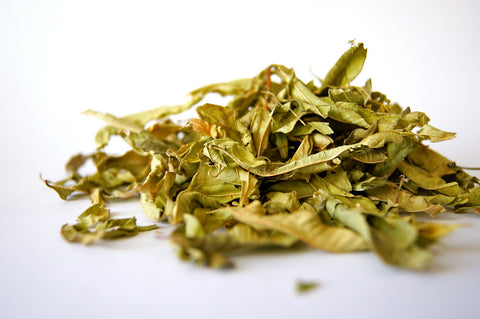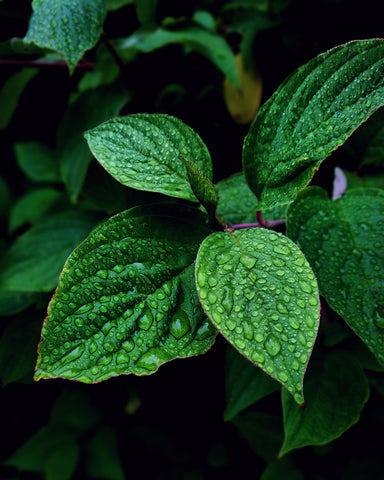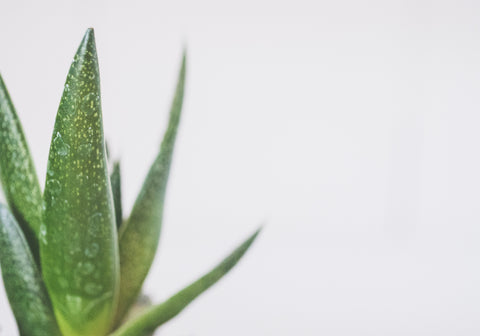Ingredients 101: Herbal Extracts in Skin Care and Cosmetics

Utilizing herbal preparations in products is nothing new. The majority of ancient cultures added herbs to beauty and health care products for a variety of reasons. In the past, most used herbs like Rose or Jasmine to add color or scent to products. Nowadays herbal extracts are incorporated for these reasons but also for therapeutic benefits, texture effects, and even to act as preservatives against microbial growth. Popular examples are Green Tea for its antioxidants, Tea Tree for its anti-bacterial effects and Oats for their soothing and healing properties.
Why Do Some Plants Have Antioxidant, Anti-Bacterial, or Soothing Properties?
Basically it comes down to transportation. Plants may grow over distances, have their seeds carried to a different location by hitching a ride on/in animals or by the wind, but for the most part--plants don't move. So if a stressful situation arose, the plant couldn't move to shelter, travel far for food or water, or couldn't retreat from predators. Therefore, through years of evolution, plants have adapted by developing a large array of chemicals that can help them defend against predators (poisons), survive environmental stress or resist disease (antioxidants) and enhance their reproduction (phytoestrogens). These and other chemicals are what give rise to the therapeutic or aesthetic properties of herbs to humans as well as plants. These chemical constituents are also what contribute to naturally derived pharmaceutical medicines like the anti-cancer drug Taxol from Pacific Yew or cardiac medications from Digitalis.
Most people aren't really aware that all plants contain chemicals. Primary metabolites such as proteins, carbohydrates and vitamins etc. are essential nutrients that the plant needs to grow and survive. On the other hand, secondary metabolites are a very large group of chemicals that are considered non-essential for a plant's survival however increase a plant's chance at survival, growth, reproduction and even aesthetics. There are a number of secondary metabolites in every plant. It has been estimated that most plants contain about 200-1000 different chemicals and that this quantity and type can differ within plants parts and from season to season. Tannins, the compounds that are responsible for making wine taste dry are one of many secondary metabolites a plant can produce and can produce them varyingly each year depending on the stresses the plant endures. Most secondary metabolites that are used in skincare or body care products for therapeutic actions are flavonoids that exhibit antioxidant benefits. However, there are also compounds that have anti-inflammatory, anti-bacterial, emollient, demulcent, hormonal and UV protection actions to name a few.
- Plants have adapted by developing a large array of chemicals that can help them defend against predators
- Plant chemicals are what give rise to the therapeutic or aesthetic properties of herbs to humans
- It has been estimated that most plants contain about 200-1000 different chemicals
- Secondary metabolites are a large group of chemicals that are considered non-essential for a plant's survival, but increase a plant's chance at survival, growth, reproduction and even aesthetics

________________________________________________________________________________________________________________________________________________
Common Plant Secondary Metabolites and General Properties and Actions
For personal care products like body lotions or facial moisturizers, herbs can be incorporated in different ways.
Some herbs are used in powdered form where the whole, bulk plant or plant part (i.e. root or flower) is ground up into a fine powder. Others are chemically extracted with solvents like water, alcohol or oil and then added direct or once extracted, freeze dried back into a powder and then added into the formula. Another form consists of extracting the crude herb containing hundreds or thousands of plant secondary metabolites, separating the different compounds into their individual components to acquire a single chemical compound usually referred to as the active constituent. Active means that this single, secondary metabolite is considered primarily responsible for the therapeutic benefits of the plant. Allantoin from Comfrey, Arbutin from Uva Ursi, Hypericum from St. John’s Wort and Epigallocatechin from Green Tea are common active constituents. Either a crude mixture of extracts or a single constituent can be used in the formula, or a combination of both.

Antioxidant, anti-inflammatory and repairing properties of secondary metabolites are largely common amongst most plants and are by far the most commonly incorporated into products for these benefits. Providing compounds and vitamins to skin to reduce DNA damage from free radicals, reduce the primary and secondary effects of inflammation and heal or repair damaged tissues generates a much more robust product that extends far greater than simple moisturizing. Aloe, Green Tea, Coffee Berry, Willow, Chamomile are just a few of many herbs that contain phytochemicals exhibiting these actions.
For scent purposes, essential oils either distilled from the plant and incorporated into the formula or found within the crude extract and combined with other secondary metabolites can contribute greatly to the product’s aroma. Most essential oils also have anti-bacterial and anti-viral properties and therefore can be added to products for the purpose of preservation from microbial attack or to help reduce infection from p. acnes the bacteria responsible for most acne.
Plant pigments that give flowers, fruits and vegetables their bright colors usually provide a host of antioxidant and vitamin properties but also can be used to color products. The red hue of Beets and yellow of Turmeric are two common natural coloring agents.
Some plants like Slippery Elm and Acacia have polysaccharides that give demulcent (soothing) effects when extracted with water creating a somewhat viscous, gum-like substance that not only soothes and reduces inflammation to irritated tissues but also can indirectly increase the viscosity of a formula reducing the need for thickening agents. Plants that contain fixed oils like Olive or Avocado oils provide moisturizing, healing and protection from moisture loss.

_____________________________________________________________________________________________________________________________________________________
Table.2 Plant Crude Extracts & Active Constituents and Their Main Cosmetic Properties
Essential oils along with other anti-bacterial, anti-fungal and antioxidant secondary metabolites are creating new potentials as chemicals for product preservation against microbes. These natural ingredients are used in products not only as a new, effective form of product preservation but also applying their anti-microbial actions to skin conditions such as acne, secondary infections from wounds and fungal infections.

Table.3 Common Phytochemical Actions
Antioxidant – Many secondary metabolites have antioxidant properties. They protect our skin and bodies from free radical damage and therefore reduce the possibility for further damage to our DNA. Being that they also reduce damage, they can help activate skin’s own healing and repairing mechanisms making it healthier. Flavonoids from fruits and vegetables, carotenoids from carrots, polyphenols from tea, allyl sulfides from garlic are common sources.
Anti-inflammatory – Along with antioxidant activity many phytochemicals can reduce the inflammatory response which helps to reduce redness, irritation, swelling, pain and speeds healing. Salicylic acid from White Willow bark is the most commonly known phenolic that does this and in fact Acetylsalicylic acid which happens to be a modified form of Salicylic acid is what makes up Aspirin.
Hormonal – Some phytochemicals like isoflavones from Black Cohosh have a similar chemical structure to estrogen. These compounds can therefore mimic their behavior and being small enough to penetrate through dermal tissues can enter the bloodstream helping to reduce symptoms of PMS and menopause when applied topically.
Anti-bacterial – Compounds that help the plant fight disease and kill off bacterial, fungal or viral infestation also exhibit these properties to humans when added to formulas. These compounds can either help kill off acne bacteria, infections from minor cuts or wounds and skin fungal infections or also act as natural anti-microbial preserving agents so the products themselves do not become contaminated.
Repairing – Promoting cell repairing and wound healing properties are common actions for many classes of secondary metabolites. Some phenolics, terpenes and even some alkaloids can help repair and heal cuts, scrapes, blemishes and irritations.
Soothing/Moisturizing – Fixed oils from plants provide a rich source of Omega-3 fatty acids and help to moisturize, heal and protect skin from moisture loss. Mucilages and polysaccharides form gels that can soothe irritated or inflamed tissues while also protecting it from further insult.
Aromatic/Scent – Essential oils are by far the most common form of secondary metabolites that contribute to scenting products naturally. They also lend their effects to being therapeutic agents as well.
Colorants – Pigments from flavonoids and anythocyanins contribute to the pigments of the plant kingdom. These natural pigments can be dried and powdered or extracted into a liquid then added to any skincare or body care formula for coloring purposes as well as providing antioxidants.
_______________________________________________________________________________________________________________________________________________________
There is a whole world out there of natural product potential. Millions more secondary metabolites probably exist in plants that we may not even have discovered yet or in plants that may just develop a new chemical compound in Mother Earth’s chemical lab of her own. By incorporating herbal extracts or herbal products into body care, skin care and everyday beauty or healthcare products one is not only providing aesthetically pleasing products but also products that are therapeutic, more eco-friendly and overall more beneficial for our well-being. With more discovery and research into these phytochemicals; the greater ability we have to create more natural, therapeutic and unique products for our everyday lives.
At RD Alchemy Natural Products we incorporate many herbs and high concentrations of herbs into our products. Crude extracts, active constituents, single herbs and blends for use as natural colorants, scents, therapeutic qualities and formulation enhancers like thickeners, penetration enhancers and preserving agents form the basis of our ingredients.
Want more in depth information to different skin care ingredients and how to use them? Check out our new e-book / paperback available on Amazon.com: Your Best Skin Yet: Popular Natural Ingredients In Skincare and How to Use them: A quick guide to common and natural ingredients to formulate skincare at home or in a professional setting

References:
- Practical Uses of Botanicals in Skincare by Alison F. Stallings, MD and Mary P. Lupo, MD (2009)
- Main Benefits and Applicability of Plant Extracts in Skin Care Products by
Ana Sofia Ribeiro, Marilene Estanqueiro, Beatriz Oliveira and José
-
Manuel Sousa Lobo (2015) www.mdpi.com/journal/cosmetics
